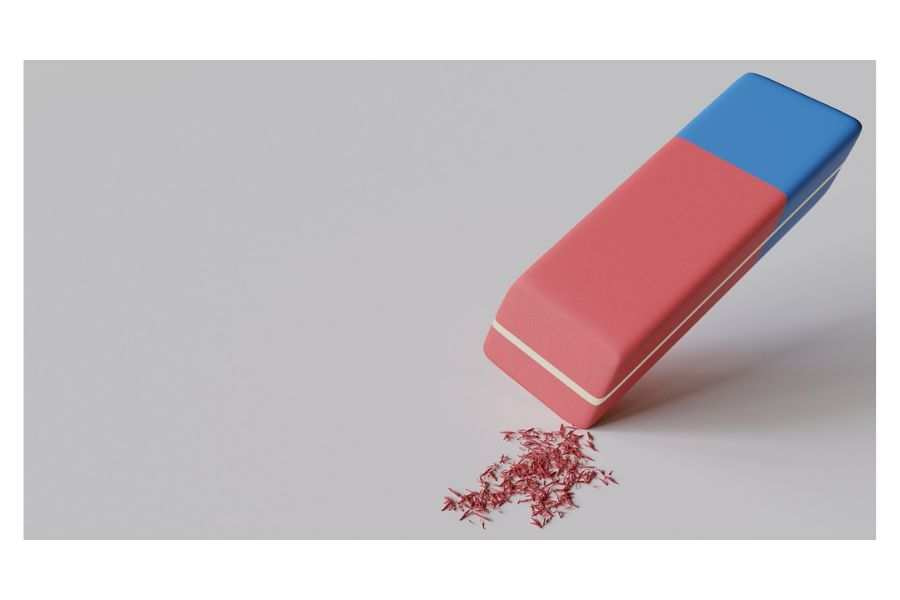You probably don’t think much about your pencil eraser, but this handy little piece of rubber has a surprisingly interesting history. Let’s learn more about how pencil erasers came to be!

The Discovery of Graphite for Pencils
Our story begins in 1564 in Keswick, England where graphite was first discovered. The locals found they could use this soft black mineral to mark on paper.
They wrapped string around it to create what we now know as the simple pencil!
The Problem of Smudges and Marks
Early pencils didn’t have erasers, so marks on the paper were difficult to remove. People tried using breadcrumbs to rub away the graphite smudges, but this wasn’t very effective.
Messy fingers from using the pencils were also a problem! A proper erasing solution was needed.

Early Origins of Erasing
The origins of erasing can be traced back to ancient Rome and Egypt. Ancient scribes used plant-based materials like papyrus to create documents.
They would rub away errors using pumice stone. Its rough, abrasive texture was ideal for scraping off ink or pencil markings.
The pumice stone method continued to be the erasing standard for centuries. However, it had limitations.

The process was messy and often tore up the paper surface. By the Middle Ages, a softer substitute was found – stale bread!
The porous crumbs could absorb graphite markings. Of course, this temporary fix still left much to be desired.

The Introduction of Rubber Erasers
The eraser revolution began in 1770 when British engineer Edward Nairne invented the ‘rubber’. Up until then, rubber was only used to erase pencil lines from paper.
Nairne conceived of a rubber attached to a pencil for easy erasing as you write. This innovative device was dubbed the ‘rubber pencil’.
The British scientist Joseph Priestley saw how useful this rubber could be. He wrote:
“I have seen a substance excellently adapted to the purpose of wiping from paper the mark of black lead pencil.”
Joseph Priestley
The Challenge of Keeping Rubber Erasers
At first, rubber erasers had a big problem – they rotted quickly! It wasn’t until 1839 when Charles Goodyear discovered vulcanization, a process that made rubber more durable, that rubber erasers became practical.

Inventing the Eraser-Tipped Pencil
In 1858, a man named Hyman Lipman in Philadelphia, USA had a clever idea. He attached a small piece of rubber eraser to the end of a pencil!
However, this didn’t last long. Soon, courts ruled that this wasn’t different enough from existing erasers and pencils to be considered a new invention.
How Erasers Work
It’s simple science – eraser molecules stick to graphite molecules better than paper molecules. When you rub the eraser on pencil marks, it lifts the graphite off the page for clean and easy erasing!
So next time you use your pencil eraser, think about how this little piece of rubber has evolved over history to become an important part of writing!
The eraser is an unsung hero that keeps our pencils neat and tidy.
Read: Everything You Need to Know about Cardstock Paper
Evolution of Styles and Materials
While the classic rectangular eraser has stayed largely unchanged, new eraser types emerged over the 20th century.
In the 1920s, Staedtler introduced the first plastic eraser. Plastic allowed for color options beyond plain rubber grey.

Art gum erasers also became popular for effectively cleaning sketches without damaging paper.
Kneaded erasers could be molded into points or wedges for precision erasing. And efficient electric erasers were a boon for artists.
Today, erasers come in a spectrum of materials like vinyl, silicone, and melamine foam.
Each caters to different needs from rubbing out pen ink to erasing whiteboards or wall scuffs. The humble eraser continues to evolve for optimal mistake removal.
FAQs
When was the first patented eraser invented?
Hyman Lipman patented the first pencil with an attached eraser in 1858. He cleverly called it the “pencil with attached eraser”.
How did people erase before rubber erasers?
Before rubber erasers, people used abrasive materials like pumice stone, stale bread crumbs, or sandpaper to rub away graphite or charcoal marks. However, these often tore up the paper.
What makes rubber good for erasing?
Rubber has just the right amount of friction and grit to lift off graphite and pencil markings without overly damaging the paper. The elasticity of rubber also allows it to conform to uneven surfaces.
When were plastic erasers invented?
Staedtler introduced the first plastic erasers in the 1920s as an alternative to rubber. Plastic provided more color options. However, rubber still remains the preferred material for standard pencil erasers.
Are some eraser types better than others?
It depends on your use. Kneaded erasers are great for artists for soft, subtle erasing. Plastic erasers work well for erasing ink. Pencil cap erasers are handy for writing errors. Choose based on your specific needs.
Conclusion
The humble eraser has come a long way from its crude beginnings. While items like bread and pumice did the job earlier, they were messy and destructive. The revolutionary rubber eraser of the 1700s was the real game-changer.
Brands later fine-tuned materials and production to create high-quality erasers. The attached eraser-tipped pencil made erasing on-the-go easy.

And we now have a range of eraser types and materials for different applications.
Erasers are a testament to human creativity. We are continuously searching for better solutions, however small.
The journey of the eraser reminds us how incrementally improving everyday tools can have a big impact. What other “mundane” items might still be ripe for reinvention? Leave your comment by visiting our Contact Us page.
You can check Britannica website to know more about erasers.

Leeisha
Creative Artist
Leeisha is a talented artist with a passion for drawing, coloring, painting, and making paper crafts. Known for her charming and talkative personality, She always finds new and exciting ways to bring her imagination to life. Whether through sketching, coloring, or paper crafting, Leeisha has a gift for turning her ideas into beautiful works of art.






